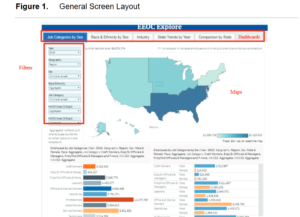On December 2, 2020, the Equal Employment Opportunity Commission (“EEOC”) announced a new interactive data search and mapping tool, named “EEOC Explore,” which permits users to access “the most current, granular, and privacy protected aggregate EEO-1 data publicly available,” covering over 56 million employees and 73,000 employers across the United States. According to the agency, EEOC Explore “enables stakeholders to explore and compare data trends across a number of categories, including location, sex, race and ethnicity, and industry sector without the need for experience in computer programming or statistical analysis.”
EEOC Explore uses aggregate information from employer EEO-1 reports, which are collected annually from private employers with 100 or more employees and federal contractors with 50 or more employees. Currently, the aggregated dated is only from two years, Fiscal Years 2017 and 2018, although FAQs the EEOC released in conjunction with the tool’s launch state that the agency will eventually add data from prior years to the database upon de-identification and organization into Public Use Files. This process ensures the confidentiality of the data by eliminating the means for identifying any particular employer or employee in compliance with Section 709 (e) of Title VII of the Civil Rights Act of 1964, as amended by the Equal Employment Opportunity Act of 1972.
Importantly, the EEOC Explore launch includes a User Guide, which provides detailed instructions on how to use the tool to obtain the specific information desired. The tool contains the following features:
- Five interactive dashboards, each of which provides a specific view of data using relevant maps and graphs:
After selecting a dashboard, the user can then filter the data further, by year, geography, sex, race/ethnicity, job category, NAICS code (2-digit), and NAICS code (3-digit) to view more granular data, as illustrated in the following map:

Other features of EEOC Explore include the ability to:
- Filter and sort data.
- View details about specific data points through “Tooltips.”
- Select marks to highlight data points in the view.
- Ascertain time trends.
- Compare geographic locations.
- Export screen display to PDF.
- Download underlying data from a visual object.
The EEOC’s Chief Data Officer, Dr. Chris Haffer, asserts that EEOC Explore’s features will make “tracking employment trends as simple as a few clicks, particularly for those analyzing job patterns for minorities and women in private industry.”
It is too soon to tell if the availability of this data will lead to increased enforcement or litigation exposure for employers. We will continue to monitor for relevant developments and update as needed. If you have any questions about the tool, please contact the authors or your Epstein Becker Green attorney directly.